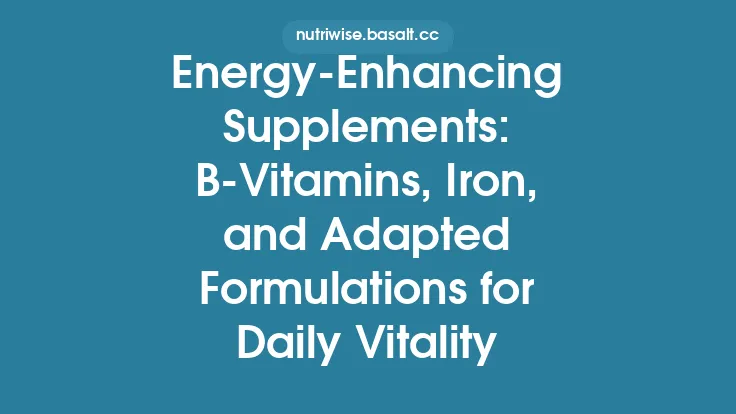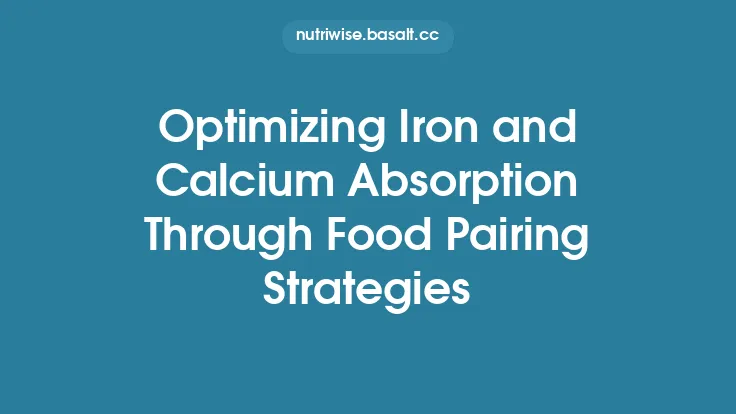Boosting Iron Status Naturally: Tips and Strategies
Maintaining adequate iron stores is essential for the production of hemoglobin, the transport of oxygen, and the proper functioning of many enzymatic pathways. While iron deficiency can develop for a variety of reasons, most people can improve their iron status through a combination of dietary choices, culinary practices, physiological support, and careful monitoring. The following guide outlines evidence‑based, evergreen strategies that can be incorporated into everyday life to help the body retain and recycle iron more efficiently, without relying on high‑dose supplements or drastic dietary overhauls.
Assessing Your Current Iron Status
Before implementing any strategy, it is prudent to know where you stand. The most reliable indicators include:
| Parameter | What It Reflects | Typical Reference Range* |
|---|---|---|
| Serum Ferritin | Stored iron | 30–300 ng/mL (women) / 30–400 ng/mL (men) |
| Hemoglobin (Hb) | Functional iron in red cells | 12–16 g/dL (women) / 13–17 g/dL (men) |
| Transferrin Saturation (TSAT) | Percentage of iron‑binding sites occupied | 20–50 % |
| Soluble Transferrin Receptor (sTfR) | Cellular iron demand | 0.8–2.2 mg/L |
| Complete Blood Count (CBC) indices (MCV, MCH) | Red‑cell size and hemoglobin content | Context‑dependent |
*Reference ranges can vary slightly between laboratories.
A baseline panel provides a snapshot of both iron stores (ferritin) and functional iron (hemoglobin, TSAT). If any values fall outside the normal range, a healthcare professional can help identify underlying causes—such as chronic blood loss, malabsorption, or inflammatory conditions—before you embark on a natural‑boosting regimen.
Optimizing Dietary Patterns for Iron Retention
Even though the focus here is not on listing specific iron‑rich foods, the overall composition of the diet influences how efficiently the body retains iron. Consider the following principles:
- Balanced Macronutrient Distribution
- Protein: Adequate high‑quality protein supplies the amino acids necessary for the synthesis of heme‑containing enzymes and for the structural integrity of red blood cells. Aim for 0.8–1.0 g per kilogram of body weight daily, adjusting upward for active individuals.
- Healthy Fats: Certain fatty acids, particularly omega‑3s, support membrane fluidity of erythrocytes, indirectly aiding iron transport. Include sources such as flaxseed, walnuts, and fatty fish.
- Micronutrient Synergy
- Copper: A co‑factor for ceruloplasmin, copper facilitates the oxidation of ferrous (Fe²⁺) to ferric (Fe³⁺) iron, a step required for iron export from cells. Dietary sources include nuts, seeds, and organ meats.
- Zinc: While high zinc can compete with iron for transport proteins, moderate intake supports overall immune health, reducing inflammation that can sequester iron.
- B‑Vitamins (especially B6, B12, and Folate): These vitamins are essential for erythropoiesis. Ensuring adequate intake helps the bone marrow efficiently incorporate iron into new red cells.
- Meal Timing and Distribution
- Spreading iron‑supportive nutrients across the day prevents prolonged periods of low availability. For example, consuming a protein‑rich snack mid‑morning and a balanced lunch can sustain amino acid supply for ongoing erythropoiesis.
Cooking Techniques that Enhance Iron Availability
The way food is prepared can markedly affect the amount of iron that remains bioavailable after ingestion. Below are culinary methods that naturally boost iron status without altering the fundamental nutrient profile.
- Utilize Cast‑Iron Cookware
- Cooking acidic or moist dishes (e.g., stews, tomato‑based sauces) in cast‑iron pots can leach small amounts of elemental iron into the food. Over time, this modest contribution can accumulate, especially when the same cookware is used regularly.
- Soaking, Sprouting, and Fermentation
- Soaking: Soaking legumes, grains, and nuts for several hours reduces phytate content, a compound that can bind iron and limit its release during digestion.
- Sprouting: Initiating germination further degrades phytates and activates endogenous enzymes that liberate bound minerals.
- Fermentation: Fermented foods (e.g., tempeh, sourdough) contain microbial activity that can convert iron into more soluble forms, enhancing its retention.
- Gentle Heat and Minimal Water Loss
- Over‑cooking vegetables can cause leaching of water‑soluble minerals into cooking water, which is often discarded. Steaming or quick sautéing preserves iron within the plant matrix.
- Avoid Excessive Use of Calcium‑Rich Additives During Cooking
- While calcium is vital, large amounts added during the cooking of iron‑containing foods (e.g., sprinkling copious cheese on a bean dish) can form insoluble complexes that reduce iron’s availability. Use calcium‑rich ingredients strategically, separate from iron‑dense preparations.
Supporting the Body’s Iron Recycling Processes
The human body recycles roughly 20 mg of iron each day through the breakdown of senescent red blood cells—a process known as erythrophagocytosis. Optimizing this internal loop can improve overall iron status.
- Maintain Adequate Hepcidin Regulation
- Hepcidin, a liver‑derived peptide, governs iron egress from macrophages and intestinal cells. Chronic inflammation elevates hepcidin, trapping iron within storage sites. Anti‑inflammatory dietary patterns (rich in omega‑3s, polyphenol‑dense foods, and low in refined sugars) help keep hepcidin levels in balance.
- Promote Efficient Macrophage Function
- Certain nutrients, such as vitamin A and zinc, are essential for macrophage health. Ensuring sufficient intake supports the clearance of aged erythrocytes and the release of iron back into circulation.
- Facilitate Proper Spleen Function
- The spleen filters and recycles red cells. Regular moderate physical activity (e.g., brisk walking) promotes healthy splenic circulation, indirectly aiding iron turnover. (Note: This recommendation does not delve into broader lifestyle factors beyond the scope of the article.)
Strategic Use of Natural Supplements and Botanicals
When dietary and culinary adjustments are insufficient, targeted natural compounds can provide a gentle boost without the risks associated with high‑dose synthetic iron tablets.
| Supplement | Mechanism of Action | Typical Dose (Adults) |
|---|---|---|
| Mushroom‑Derived Polysaccharides (e.g., β‑glucans) | Modulate immune response, reducing chronic inflammation that can elevate hepcidin | 500 mg–1 g daily |
| Nettle Leaf (Urtica dioica) Extract | Provides a modest amount of iron along with supportive micronutrients (copper, vitamin C from the plant matrix) | 300–600 mg of dried leaf powder |
| Spirulina (Arthrospira platensis) | Contains phycocyanin, which may aid in erythropoiesis, and a small amount of iron in a highly bioavailable form | 1–3 g daily |
| Blackstrap Molasses | A natural source of iron, copper, and calcium; the iron is present as a soluble complex | 1–2 tbsp (≈20 g) |
| Herbal Adaptogens (e.g., Ashwagandha) | Reduce physiological stress, indirectly supporting normal hepcidin regulation | 300–500 mg standardized extract |
Key Considerations
- Choose high‑quality, third‑party tested products to avoid contaminants (e.g., heavy metals).
- Start with the lowest effective dose and monitor tolerance.
- Natural supplements should complement, not replace, a balanced diet and medical evaluation.
Managing Blood Loss and Iron Conservation
Even in the absence of overt disease, subtle chronic blood loss can erode iron stores. Strategies to minimize unnecessary losses include:
- Menstrual Management
- For individuals experiencing heavy menstrual bleeding, medical evaluation is essential. In the interim, using non‑hormonal hemostatic agents (e.g., tranexamic acid mouthwash under professional guidance) can reduce loss.
- Gastrointestinal Health
- Conditions such as peptic ulcers or inflammatory bowel disease can cause occult bleeding. Regular screening (e.g., fecal occult blood test) for at‑risk individuals helps catch hidden losses early.
- Phlebotomy and Blood Donation
- While altruistic, frequent blood donation can deplete iron stores. If donating regularly, schedule intervals that allow for full replenishment (typically 8–12 weeks) and consider iron‑supportive nutrition in the interim.
Regular Monitoring and When to Seek Professional Guidance
Natural strategies are most effective when paired with periodic assessment. Recommended monitoring schedule:
- Baseline: Full iron panel (Ferritin, Hb, TSAT, sTfR) before initiating changes.
- Follow‑Up: Repeat testing every 3–6 months, depending on initial results and any ongoing symptoms.
- Red Flags Requiring Immediate Attention:
- Sudden drop in hemoglobin (>2 g/dL)
- Ferritin <15 ng/mL (indicative of depleted stores)
- Persistent fatigue, shortness of breath, or palpitations despite dietary adjustments
If any red flag appears, consult a healthcare professional promptly. They may order additional investigations (e.g., endoscopy, colonoscopy) to rule out hidden sources of loss or malabsorption.
Putting It All Together: A Practical Action Plan
- Establish Baseline – Obtain a comprehensive iron panel.
- Adjust Dietary Pattern – Ensure adequate protein, copper, zinc, and B‑vitamins; distribute meals evenly.
- Adopt Iron‑Friendly Cooking – Use cast‑iron cookware, incorporate soaking/sprouting, and avoid discarding cooking liquids when feasible.
- Support Recycling – Incorporate anti‑inflammatory foods, maintain moderate physical activity, and consider mushroom polysaccharides or spirulina as adjuncts.
- Consider Targeted Botanicals – Add a modest dose of nettle leaf extract or blackstrap molasses if dietary changes alone are insufficient.
- Monitor Blood Loss – Address menstrual or gastrointestinal sources proactively.
- Track Progress – Re‑test iron markers at 3‑month intervals; adjust the plan based on results.
By integrating these evidence‑based, evergreen strategies, most individuals can enhance their iron status naturally, reduce reliance on high‑dose supplements, and support overall vitality. Remember that iron metabolism is a dynamic system; consistent, moderate interventions tend to yield the most sustainable outcomes.





